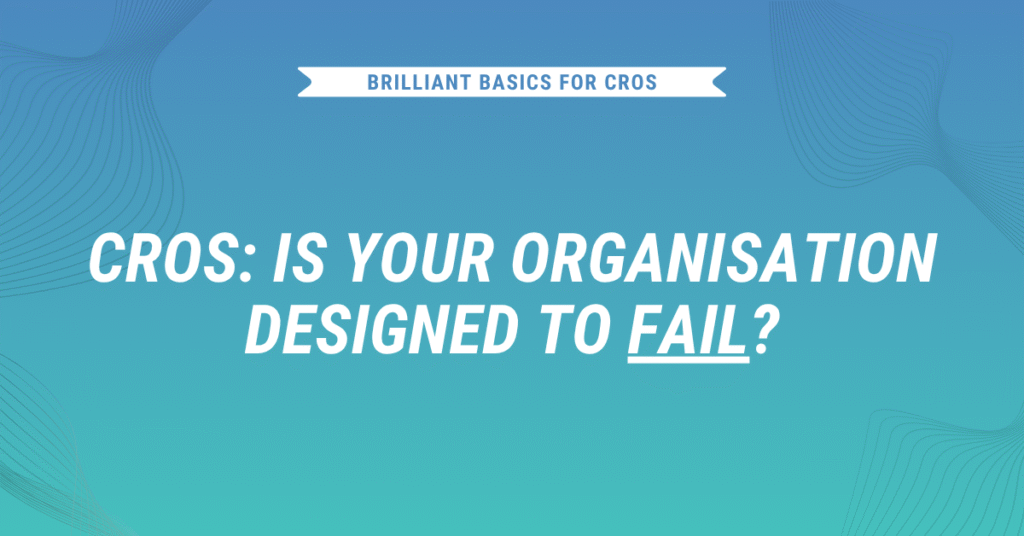CROs! Is Your Organisation Designed to Fail?
I’ve been beating the drum in recent months about the shifting landscape for CROs. Buyer profiles and habits have evolved, as customers demand new ways of interacting.
I’ve witnessed a clear shift in how B2B organisations engage with their customers, with CROs adapting to these evolving dynamics. For example, I’ve seen a significant increase in the number of hybrid sales roles, catering to less traditional customers who are more comfortable with remote human interactions and self-service through digital channels.
This shift has important implications for CROs. They need to rethink skill requirements, establish new ways of working, and push cultural boundaries. But this brings risks. Not every team member wants to change how they work—or where they work. I’ve seen multiple survey statistics indicating that staff turnover is significantly increasing, while employee engagement is declining.
Now, more than ever, companies must ensure that customers are truly at the centre of their business. This means improving routes to market and leveraging both technology and talent. The business needs to be “outside-in”! In simple terms, CROs must ensure they have an up-to-date and fit-for-purpose operating model.
The most common CRO organisation uses a basic functional design. But, of course, there are variations – matrixed, pod-based, etc. – to reflect the diversity of sectors, products, and footprints. When designing the CRO’s organisation, what are the key considerations?
In keeping with my ‘Brilliant Basics’ approach, here are a few thoughts:
1. Agree on your specific mandate as a CRO
This may sound obvious, but it’s often glossed over. Establish clarity from your stakeholders (e.g. your CEO) on your specific scope, authority, and objectives. Align on outcomes such as revenue growth, CLTV, retention, and customer satisfaction.
With this clarity, you can justify which functions report into you, typically Sales, Marketing, and Customer Success, as a minimum. I would also make the case for RevOps and Partnerships to be included.
2. Understand the customer journey & revenue lifecycle
Map the full end-to-end revenue engine. Document the customer journey from first contact through to lead, opportunity, close, onboarding, and into renewal and expansion.
Identify handoff points and where revenue is created – or lost. I always recommend physically walking through this journey to experience it from the customer’s perspective.
Understanding this lifecycle allows you to align teams and metrics across the entire customer experience, not just the initial sale.
3. Segment the market and go-to-market motion
Stay customer-centric. Tailor your organisation to the needs of your buyers and market segments. Define your ideal customer profiles (ICPs), segments, and buyer personas.
Once you know who your most important customers are (by scale or growth opportunity), you can map your GTM coverage: inbound, outbound, partner-led, product-led, account-based, etc.
Smaller customers may be happy with online self-service. Larger, more complex customers benefit from face-to-face account management, supported by product or technical specialists.
4. Quantify the potential return on investment
Map out your core functions and draft an initial operating model (I use a simple ROI spreadsheet—reach out if you’d like a free copy). Define roles clearly and include fully allocated costs per head alongside revenue expectations.
This draft becomes your ammunition when discussing budgets and headcount. I always coach CROs to have a proactive conversation with the CFO: “If I have this much resource, I can deliver this much revenue growth.” That’s what ambitious stakeholders want to hear.
5. Inject agility
Leverage cross-functional capabilities—beyond the CRO’s remit—to unlock growth. For example, forming a Proposition Roadmap team with Product and Tech functions helps sales and marketing accelerate speed to market and revenue generation.
Win rooms are another powerful tactic. They promote collaboration and rapid decision-making in a focused environment, physical or virtual.
6. Recruit team leaders who are better than you
Be humble. As a CRO, recognise your strengths but also your limitations. Surround yourself with subject-matter experts—leaders who challenge you, not “yes people”.
7. Build a drumbeat operating rhythm
It’s an operating model – not just an org chart. Success depends on syncing activity across the customer journey with aligned KPIs.
Establish regular operational reviews – daily, weekly, monthly. Use RevOps to build dashboards that offer insight, not just data. No waffle, just clear, factual intelligence. Forecasting should follow the same discipline.
It’s rare that CROs design their organisation from a blank slate. Most businesses evolve, shaped by scope creep, bolt-on acquisitions, and shifting priorities. But that’s no excuse to tolerate a sub-optimal structure.
Uncoordinated and poorly designed organisations are lethal for CROs.
Take a fresh look at yours, do any of these ideas spark a rethink? I’d love to hear your feedback.

 Don’t Miss My Next Webinar – It’s Today!
Don’t Miss My Next Webinar – It’s Today!
Your career as a CRO could depend on it.
Tomorrow, I’m lifting the lid on the 10 mistakes that even great CROs make, and why these errors quietly destroy careers, reputations, and revenue.






Sign up here 
If there’s one session this quarter you need to make time for, it’s this.
Enjoy this newsletter? Subscribe to the newsletter via LinkedIn, repost to your network or learn more about me, Alan Crowther, and Optilium here.


